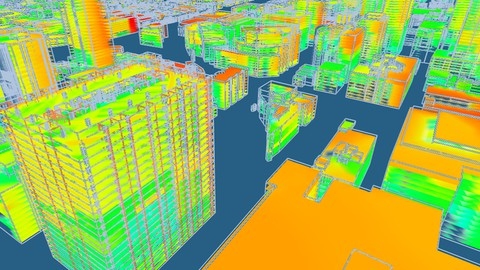5G technology is revolutionizing the way we connect, promising lightning-fast speeds, ultra-low latency, and the ability to support a massive number of connected devices.
Understanding the intricacies of 5G, from its architecture and key principles to its impact on various industries, is crucial for anyone looking to thrive in the ever-evolving tech landscape.
Whether you’re an aspiring engineer, a tech enthusiast, or simply curious about the future of connectivity, a solid grasp of 5G is an invaluable asset.
Finding the perfect 5G course on Udemy, however, can be a daunting task.
With a plethora of options available, each promising to unlock the secrets of this transformative technology, it’s easy to feel overwhelmed.
You’re searching for a course that not only delves into the technical aspects but also provides practical insights and real-world applications.
You need a course that will equip you with the knowledge and skills to navigate the complexities of 5G and contribute to its ongoing development.
After careful consideration and thorough review, we’ve identified 5G: Architecture and Key principles as the best overall 5G course on Udemy.
This comprehensive course provides a deep dive into the fundamental concepts and architecture of 5G, offering a clear and concise explanation of its key components and functionalities.
From the evolution of mobile communication to the intricacies of the 5G Radio Access Network (RAN) and core network, this course equips you with a solid foundation in 5G technology.
While 5G: Architecture and Key principles is our top recommendation, we understand that your learning needs may be unique.
That’s why we’ve compiled a list of other exceptional 5G courses on Udemy, each catering to different learning styles and areas of focus.
So, keep reading to explore our comprehensive guide and discover the perfect 5G course to embark on your journey into the future of connectivity!
5G: Architecture and Key principles
This course on 5G architecture and key principles equips you with a comprehensive understanding of this revolutionary technology.
You start by tracing the evolution of mobile communication, understanding what makes 5G stand out, and exploring its potential across various sectors.
You then delve into the architecture of the 5G system, exploring deployment strategies and crucial components like the 5G Radio Access Network (RAN).
The course thoroughly explains concepts like MIMO, which boosts data transmission efficiency, and delves into the intricacies of 5G spectrum and dual connectivity.
You learn how flexible numerology allows the network to adapt to changing traffic demands.
The curriculum also illuminates scheduling techniques, Quality of Service mechanisms, and how 5G caters to the massive number of devices in the Internet of Things through MMTC.
Moving beyond the RAN, you explore the 5G core network.
You uncover the significance of virtualization and Network Functions Virtualization (NFV) in building flexible 5G networks.
You gain a solid understanding of network slicing, a key concept that enables the customization of network resources for different applications and services.
This course empowers you to confidently explain 5G’s core technologies and their pivotal role in shaping the future of mobile communication.
5G: Technologies, Architecture And Protocols
This 5G course takes you from the basics of mobile technology all the way to the complex workings of 5G networks.
You start by tracing the evolution of mobile networks from 1G to 5G.
You explore the ITU-R vision for 5G and understand why 5G is such a big leap forward.
You then dive into the core 5G architecture, understanding the differences between standalone and non-standalone deployments and their importance in the real world.
You learn how 5G New Radio (NR) works, including key technologies like OFDMA, flexible numerology, and advanced 256 QAM modulation, all of which contribute to 5G’s incredible speed.
You discover the power of massive MIMO and beamforming, and how these technologies boost network capacity and coverage.
You explore the 5G network architecture in detail, from the gNB, which transmits and receives data, to the control and user planes that manage different types of network traffic.
This course also teaches you about the crucial functions within the core network, including the AMF, which manages your connection to the network, and the SMF, which controls your data sessions.
You delve into network function virtualization (NFV) and network slicing and learn how they make 5G networks more adaptable and efficient.
You study essential processes like UE registration, paging, and handover, which are vital for a seamless mobile experience.
You discover how the service-based architecture (SBA) uses HTTP/2 and RESTful APIs to enable smooth communication between different parts of the network.
You explore network slicing in detail, learning how it allows operators to create virtual networks on top of the physical network to support different applications with varying requirements.
This course also equips you with the knowledge of 5G security, including authentication and key agreement (AKA) procedures that protect your data.
You discover how voice calls work over 5G, using technologies like IMS and SIP.
Finally, you dive into the intricacies of the 5G NR air interface, including its channels, signals, and procedures.
You learn about important processes like cell acquisition, initial access, and data transmission, which form the foundation of 5G communication.
Understanding 5G: The Next Evolution in Wireless
You’ll start with the basics, tracing the evolution of wireless networks from older generations like 3G and 4G to the advancements of 5G technology.
You’ll gain a solid understanding of how 5G works, including key components like network architectures (including Non-Standalone and Standalone 5G networks) and the role of important 5G standards bodies.
This course goes beyond just the technical stuff, diving deep into how 5G is changing the way we live and work.
Think enhanced video streaming for your favorite shows, live sports on the go, and even the exciting possibilities of augmented reality and the metaverse.
You’ll discover how 5G is transforming industries from healthcare to retail and from automotive to finance, making them faster and more efficient.
You’ll explore the growing importance of private 5G networks, used in places like university campuses, manufacturing plants, and even oil and gas operations.
Discover how artificial intelligence (AI) and machine learning (ML) are being integrated into 5G networks, making them smarter and more responsive.
You’ll explore open-source 5G initiatives and see how collaboration is shaping the future of this technology.
This course explores how technology labs, incubators, and mobile network operators are joining forces to create a connected future.
You’ll also uncover valuable industry research resources and explore strategies for successful 5G initiatives, including how to partner with mobile network operators.
5G RF Planning
This course starts by teaching you about the 5G air interface, the communication link between your phone and the cellular tower.
You will learn how to calculate signal strength for reliable 5G service using 5G link budgets.
This involves understanding how signals travel, how to measure signal loss over distance, and how to compensate for that loss.
You will then explore propagation models, mathematical formulas that predict how radio waves travel.
By fine-tuning these models, you learn to accurately predict how signals will behave in real-world environments.
This course teaches you how to use simulation software and powerful tools like Python to create virtual 5G networks and predict their performance.
Finally, you will discover how to perform initial parameter planning for 5G networks.
This includes configuring essential parameters like PRACH, a key element that ensures smooth and efficient communication setup between your phone and the network.
You will finish the course equipped to plan and optimize real-world 5G networks for maximum performance.
5G, 4G LTE, 3G, 2G; Mobile/Cellular Networks For Beginners
This course on mobile and cellular networks begins with the basics, guiding you through the evolution of mobile technology from the early days of 1G to the lightning-fast speeds of 5G.
You learn about how mobile devices communicate, diving into concepts like uplink and downlink communication and exploring different communication methods such as simplex, half-duplex, and full-duplex modes.
This foundation in mobile communication basics is essential for understanding the more intricate details of how modern cellular networks operate.
Building on this foundation, the course explains how cellular networks manage multiple users on a single channel using technologies like FDMA and TDMA.
You uncover the world of modulation techniques like FM, FSK, PSK, and QAM, understanding how they transform information for transmission over radio waves.
The course then breaks down the “cellular” in “cellular network”, illustrating how these networks are structured using cells to manage coverage and how techniques like frequency reuse and clustering mitigate interference.
You then journey through each generation of mobile communication, from the first analog systems (1G) to the digital revolution of 2G (GSM) and the introduction of packet data with 2.5G (GPRS) and 2.75G (EDGE).
You delve into the architecture of these systems, getting familiar with critical components like the BTS, BSC, MSC, HLR, and VLR.
The course unpacks how calls are made and managed in a GSM network, detailing the intricate steps involved in connecting you to the person you’re calling.
Continuing the exploration of mobile generations, the course moves into the world of 3G (UMTS) and 4G (LTE), dissecting their architectures and revealing how they achieve higher data speeds and greater capacity.
You’ll encounter key technologies like OFDM, a cornerstone of 4G LTE, and learn how it enables efficient use of radio spectrum.
The course concludes by propelling you into the cutting-edge realm of 5G, exploring its revolutionary capabilities, from ultra-fast data rates and low latency to its ability to support a massive number of connected devices.
You learn how 5G’s architecture, using technologies like massive MIMO and beamforming, unlocks these capabilities and opens doors to innovative applications.
5G Core - Architectures, Concepts and Call Flows
This course guides you through the evolution and framework of 5G.
You begin by understanding the driving forces behind 5G, its crucial requirements, and the enabling technologies like virtualization, cloud-native architectures, and microservices.
You will also discover how they work together to enable seamless communication.
You will then explore specific core elements like UDM and PCF, learning how they manage user data and enforce network policies.
You will also understand the importance of identifiers like SUPI, SUCI, and PEI in a 5G network and how they facilitate authentication and security.
The course provides a clear understanding of how the interaction between 4G and 5G networks enables smooth transitions.
Finally, you examine how these functions work together in real-time scenarios, including registration, de-registration, and service requests.
You will learn about the different timelines involved in the 5G journey and get introduced to the 3GPP standards that guide this technology.
Through this course, you gain valuable insights into the crucial elements of 5G, preparing you for specific roles within the 5G industry and familiarizing you with industry-standard practices.
5G Masterclass: Architecture, NR RAN, Core and Call flows
This 5G Masterclass equips you with a deep understanding of 5G technology, from the fundamentals to the intricacies of network architecture and call flows.
You’ll start by grasping the basics of 5G standardization and its diverse applications.
Then, you’ll explore the core of 5G, delving into the New Radio (NR) RAN and the functions of its protocol stack.
You will understand how layers like PDCP, RLC, MAC, and PHY manage data, correct errors, and schedule transmissions.
You’ll then transition to the 5G Core Network, where you’ll uncover the role of cloud virtualization and network function virtualization.
You’ll learn about entities like AMF and SMF and how they manage access, mobility, and sessions.
The course also covers UDM and PCF, highlighting their roles in data management and policy control.
Through this, you’ll develop a clear understanding of how these entities interact to ensure seamless 5G communication.
Finally, the course prepares you for the future of 5G.
You’ll examine industry trends like DRAN, CRAN, and VRAN, understanding how these deployment models shape 5G infrastructure.
You’ll also gain insights into the Open RAN movement and initiatives like TIP and ORAN, which are driving innovation in the field.
This forward-looking approach ensures you’re not only learning about the present state of 5G but are also prepared for the advancements on the horizon, including a glimpse into the future with 6G technology.
5G O-RAN (Open RAN): Architecture, Procedures And Use Cases
This course on Open Radio Access Networks (O-RAN) will take you from the basics to cutting-edge advancements related to 5G technology.
You will begin by understanding the building blocks of a 5G network and how traditional systems have evolved into the dynamic world of O-RAN.
The course dives into the nuts and bolts of O-RAN, introducing you to crucial concepts like RAN splits, which determine how different network functions are distributed.
You will learn about the Enhanced CPRI protocol that enables seamless communication between these functions.
You will master the intricacies of virtualization techniques like VNFs and Cloud Native Network Functions, the engines behind cost-effective and efficient O-RAN deployments.
The journey continues with real-world applications and use cases.
You will explore O-RAN Traffic Steering, a technique for optimizing network traffic flow for better performance.
You will delve into Network Slicing, where you learn to create virtual networks tailored for specific needs.
The course even covers how to manage and automate these slices using ONAP, a powerful network automation platform.
To top it off, you will explore how AI and Machine Learning are transforming O-RAN.
You will learn about supervised learning techniques like Linear Regression and Neural Networks and how they can be used to predict network behavior.
You will also explore unsupervised learning methods like K-Mean clustering for identifying patterns in network data, and Reinforcement Learning for optimizing network decisions in real time.








